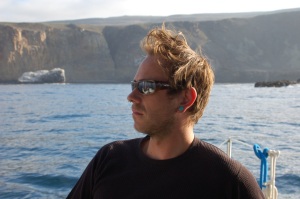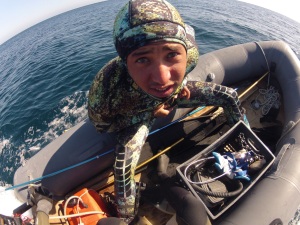Day 3.
"Don't anchor anywhere on the east side, you'll put a hole in your boat," said a few lobster guys. "It is deceptively calm and you'll just drive into a rock."
 We wanted to spend a night on the lee side of the island. It is a 15 mile expanse of unchanging, flat, intensely bold coastline. Why bother trying to anchor for the night? To get a better feel for the island, the land and its cultural history, I wanted to spend time in that side. Plus, we wanted to break up the 38nm return trip to Avalon, which is a long haul at 6 knots.
We wanted to spend a night on the lee side of the island. It is a 15 mile expanse of unchanging, flat, intensely bold coastline. Why bother trying to anchor for the night? To get a better feel for the island, the land and its cultural history, I wanted to spend time in that side. Plus, we wanted to break up the 38nm return trip to Avalon, which is a long haul at 6 knots.
But... the chart shows deep water (100ft+) right next to the cliffs for miles on end. Brian Fagan's cruising guide listed no anchorages. The locals lobstermen advised us against it. The prospects were glum.
Then we came across this book:
 In "The California Channel Islands", author Marla Daily relates the fascinating history of pioneer ranchers, entrepid businessmen, and hermits. We read about a German man who lived alone on the east side of San Clemente island for 30 years around the turn of the century. He had a fish camp for anglers and would do tours of native american artifacts. He lived at "Mosquito Cove". That is where we should go. If people visited him regularly, I figured, there must be a good landing site; possibly even a sandy beach.
In "The California Channel Islands", author Marla Daily relates the fascinating history of pioneer ranchers, entrepid businessmen, and hermits. We read about a German man who lived alone on the east side of San Clemente island for 30 years around the turn of the century. He had a fish camp for anglers and would do tours of native american artifacts. He lived at "Mosquito Cove". That is where we should go. If people visited him regularly, I figured, there must be a good landing site; possibly even a sandy beach.  The coastline was eerie. The entire east side of the island is a blank wall of cliffs with flat water like a lake. Rocks near the surface show no indication of their presence, through ripples or otherwise, because the sea is so calm. Hence the warning of the lobstermen.
The coastline was eerie. The entire east side of the island is a blank wall of cliffs with flat water like a lake. Rocks near the surface show no indication of their presence, through ripples or otherwise, because the sea is so calm. Hence the warning of the lobstermen.
We found Mosquito Cove by GPS - there was hardly any geographic feature to distinguish it. There was in fact a small cobblestone-sand beach on the shore. We approached with the depth sounder carefully; luckily the visibility was excellent and our watch on the bow could warn of shallow reefs that protruded out of the depths. We anchored in 55ft of water, with just enough distance to shore for our boat to swing.
 |
| Robby with a casserole of chicken enchiladas for lunch |
It was ominously silent and strangely claustrophobic. With their mass, the cliffs seemed to dampen any sound -- creating the type of quiet anxiety one might have felt stuck in the still airs of the doldrums while crossing the Atlantic under sail. The ravines cut deep into the land; we imagined the German man living here for decades, and it made me shiver.
 |
| Sunrise anchored at Mosquito Cove |
We motored back towards Wilson Cove, where the main Navy base is located (keeping a safe distance of 3nm). Fortified ships drove into the harbor. Trucks drove in meandering roads in the distance, with barracks lining the hillside.
The Northwest anchorage was closed for Navy activity; so we hoisted sail and crossed the channel back to Catalina. We'd have to return to see that last piece of the island, one that looked so intriguing as well.
 |
| Diving at Church Rock in Catalina on the return trip |












 Third is Robby Seid, who is a traveler, fishes salmon in Alaska, and works in mechanical design. Every time he comes aboard Aldebaran he improves the boat -- whether it's the sunglass line, the guitar rack, or just a roll of non-skid tape. We met on the Oaxaca coast and I'm glad we stayed in touch.
Third is Robby Seid, who is a traveler, fishes salmon in Alaska, and works in mechanical design. Every time he comes aboard Aldebaran he improves the boat -- whether it's the sunglass line, the guitar rack, or just a roll of non-skid tape. We met on the Oaxaca coast and I'm glad we stayed in touch.

